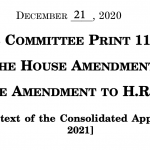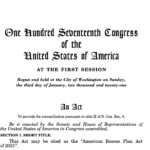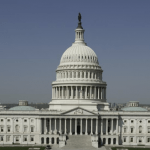The Next Covid Relief/Stimulus Bill’s Going to be a Doozy
Both House and Senate Democrats have been working behind the scenes to craft the next Covid relief/stimulus bill and the preliminary details show it’s going to be one doozy of a spending spree.
Granted, it’s not a complete surprise, considering President Biden submitted the $1.9 trillion plan to Congress, and it’s this baseline from which congressional Democrats have been working.
I mention Democrats only because a select number of Republican senators met with President Biden regarding their views and suggestions on the next Covid bill, and while the meeting was reportedly cordial, none of the proposals put forth in that meeting have been given more than a cursory nod.
And, most assuredly, those same Republican members have made their views known to House and Senate Democrats as details have been hammered out.
Unsurprisingly, it doesn’t seem too many of these suggestions have made it into the draft legislation.
That may change as the bill moves through the process, but considering the recent move by House and Senate Democrats to allow for reconciliation to pass the bill – a move that allows for passage without any Republican votes in the Senate – it seems less and less likely.
So, what’s in the current draft of this significant fiscal package?
Let’s take a look.
Democrats Covid Relief/Stimulus Bill Draft
Of most interest to many Americans is the stimulus payments and the associated income cutoffs.
Stimulus Payments
The bill would provide individuals making up to $75,000 a $1,400 payment.
Couples making up to $150,000 would receive a $2,800 payment.
And, as an example, a married couple with two dependents would receive $5,600.
Payment would begin to phase out over those amounts, with individuals making up to $87,500 receiving a $700 payment, while married couples making up to $175,000 getting $1,400. Add in two dependents and the total take for married couples in those income categories would be $2,800.
And individuals with incomes of $100,000 or more and married couples making $200,000 or more would not receive any stimulus money.
One of the Republican proposals – and that of moderate Democrats, too – was that the threshold for stimulus payments be lower ($50,000 for individuals and $100,000 for couples). Democratic leadership apparently rejected those lower thresholds.
Education and Labor
- $130 billion for kindergarten through 12th grade school reopening
- $40 billion for higher-education institutions
- $39 billion for childcare businesses
- $5 billion for extended pandemic food benefits
- $4 billion for expanded home-heating assistance
- $1.4 billion for senior-care services
- Provisions to tighten workplace safety standards for Covid-19
- Funding to subsidize health insurance for the newly unemployed, and to address a rise in domestic violence and child abuse
Housing, Transportation and Covid Equipment
- $10 billion to use the Defense Production Act to produce masks and other Covid-19 equipment
- $25 billion for rental assistance, largely run through the Treasury Department
- $5 billion in assistance for the homeless
- $10 billion for direct assistance to homeowners for mortgage payments, property taxes and utility costs
- $14 billion in payroll assistance to airlines, with $1 billion for their contractors
- $50 billion for the Federal Emergency Management Agency to deal with the Covid-19 disaster
- $30 billion for transit
- $8 billion for airports
- $1.5 billion for Amtrak
Child Tax Credit
This is a new proposal that is only loosely – at least in my view – related to Covid relief or stimulus.
Nevertheless, the Democrats have added this to their draft of the Covid relief/stimulus bill.
- Boosts the annual child credit to $3,600 a year for children five and younger and $3,000 for those six and up.
- The money would come in monthly instalments from July through December. The maximum child tax credit is currently $2,000 and is disbursed annually
- Single-parent households earning up to $75,000 or couples making $150,000 will get the full credit amounts, which will phase out for incomes above those levels
- The credits will be based on a family’s 2020 income.
And, in a move that shows true bipartisanship (sarcasm), an increase of the minimum wage is being considered as part of this bill as well. There are valid concerns that such a provision could even be included in a bill that will be passed via the reconciliation process as the latest Covid relief/stimulus likely will be. The only possible technicality that would allow it, is the Congressional Budget Office’s finding that the minimum wage increase would add $54 billion over 10 years to the budget deficit, an amount that will go straight to the U.S.’s already skyrocketing debt.
Relief is Needed, But This Much?
If you’ve read any of my previous thoughts on Covid relief/stimulus, you know I believe more is needed.
But, we also must keep an eye on the bigger financial picture in this country.
And right now, I don’t think that’s being done.
House and Senate members who call for limited and targeted additional spending this time around are spot-on.
Do families that make $150,000 really need $2,800 or more from the federal government? Likely, families in those income levels were unaffected by job loss, and thus don’t need another round of stimulus payments.
And for the areas of relief – housing, education, etc. – that are part of this bill, it’s important to understand, the vast majority of money from December’s Covid relief/stimulus bill has yet to even be spent. How do we know those are areas of true need?
America has a major debt problem. Too few, even in the ranks of our elected leaders, understand the negative consequences of continuing to spend money the U.S. just doesn’t have.
This bill is just one example.
Again, don’t get me wrong, there are definite areas of need right now as a result of Covid and governments’ subsequent actions, and they should be the focus of any relief bill.
It just seems that’s not the thinking of most of those who are now in charge of this Congress.
The tentative timeline for this bill’s consideration and passage is late February through early to mid-March.
There’s still time to develop a more rational relief bill that will make the most of the dollars it will appropriate and add to America’s $27 trillion+ debt level.
Why do I feel that’s unlikely to happen?
We’ll report the enacted bill’s details once its consideration is complete.



